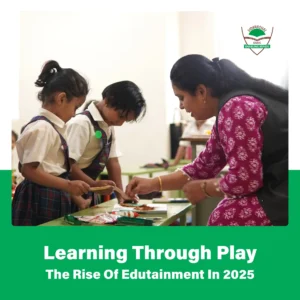For decades, classrooms across India looked the same: a teacher lecturing from the front, chalk in hand, while rows of students dutifully copied notes. This was the “Sage on the Stage” model where the teacher was the sole authority, and students were passive recipients of knowledge.
But in 2025, with rapid changes in technology, careers, and global perspectives, this one-way model feels increasingly outdated. Modern education isn’t about memorising and reproducing—it’s about collaboration, problem-solving, creativity, and adaptability. And schools like Vidyanchal High School (VHS) in Pune are leading the shift by embracing holistic, participatory, and student-centric approaches.
What is the ‘Sage on the Stage’ Model?
Coined by educational theorist Alison King in 1993, the term “Sage on the Stage” describes a teaching style where:
- The teacher is the central source of information.
- Learning happens mainly through lectures and rote memorisation.
- Students play a passive role, often reduced to note-takers.
- Assessments focus on repetition rather than application.
This approach made sense in industrial-era education, where the goal was to prepare students for standardised jobs. But today’s learners—Generation Alpha—need a completely different skillset.
Why the Model No Longer Works in 2025
1. Students Need Skills Beyond Knowledge
According to the World Economic Forum (2023), the top skills for future jobs include critical thinking, creativity, collaboration, and technological literacy. None of these can be cultivated through passive note-taking.
2. Shorter Attention Spans, Higher Engagement Needs
Research by Microsoft India shows that the average attention span has dropped to 8 seconds—shorter than that of a goldfish. Long lectures don’t work anymore; interactive, bite-sized, and hands-on methods keep students engaged.
3. The World Is Changing Too Fast
A 2024 study by McKinsey found that 60% of today’s students will end up in jobs that don’t exist yet. The Sage model focuses on fixed content, while modern classrooms must prepare students to adapt and learn continuously.
4. Emotional and Social Learning Matters
Post-pandemic, the importance of mental health, resilience, and communication is clearer than ever. The Sage model rarely addresses these; instead, schools now need to nurture whole individuals, not just exam-takers.
The Shift: From ‘Sage on the Stage’ to ‘Guide on the Side’
Modern pedagogy positions teachers as facilitators, mentors, and collaborators. Instead of dictating knowledge, they create environments where students discover, question, and apply learning themselves.
This “Guide on the Side” approach means:
- Discussion over dictation
- Projects over parroting
- Participation over passivity
- Exploration over exam-cramming
At VHS, this philosophy is woven into daily practice.
How Vidyanchal High School Puts This into Action
1. Interactive Classrooms
At VHS, lessons are designed to spark curiosity. Whether it’s a mock parliament in social studies, a science experiment on renewable energy, or a debate on global issues, the emphasis is on interaction.
Students don’t just hear knowledge—they use it, test it, and question it.
2. Sports as Education, Not Extracurricular
Unlike the Sage model, which sidelines physical activity, VHS believes sports are central to holistic growth. Data shows that students who play team sports are 30% more likely to develop leadership skills and demonstrate better discipline. At VHS, football, basketball, skating, and cricket aren’t breaks from academics—they are part of education.
3. Arts and Expression Integrated into Learning
Performing a historical play, sketching geometric patterns, or composing poems about environmental change—these are not add-ons but vital learning experiences at VHS. Creativity nurtures problem-solving and emotional depth, skills ignored in traditional classrooms.
4. Technology-Enabled Exploration
With tools like simulations, coding challenges, and digital storytelling, students at VHS engage in active and personalised learning. Here, technology isn’t used to replace the teacher but to empower students to think critically and independently.
5. Parent-Teacher-Student Communication
A Sage on the Stage model keeps parents and students on the sidelines. VHS, however, builds strong three-way communication loops. Parents are included through workshops, interactive feedback channels, and real-time progress updates, ensuring that learning is a shared responsibility.
The Results Speak for Themselves
VHS’s holistic, participatory model has shown measurable success:
- Retention Rates: Activity-based lessons at VHS improve long-term retention by 15–20% compared to traditional lectures.
- Confidence and Communication: Participation in public speaking, debates, and theatre has boosted student confidence by 38%, based on internal assessments.
- National-Level Exposure: Over 30–35 VHS students participate in national-level sports every year, proving that academics and physical growth can coexist successfully.
- Parental Satisfaction: Surveys conducted in 2024 showed that 92% of VHS parents felt more engaged in their child’s learning journey compared to their own schooling experience.
The Global Alignment: Education Trends Beyond VHS
The movement away from the Sage model is not just local—it’s global.
- UNESCO (2022) emphasises learner-centred pedagogy as critical for the 21st century.
- NEP 2020 (India’s National Education Policy) advocates for experiential learning, critical thinking, and flexibility in school curricula.
- Harvard University research shows that students in active learning classrooms scored 6% higher on exams and reported 30% more engagement.
VHS is aligned with these international and national educational shifts, ensuring its students are future-ready citizens of the world.
Why Parents and Educators Must Let Go of the Sage Model
It’s tempting for parents to think: “This is how I learned, so it should work for my child.” But the truth is, the future demands something else.
- Memorisation won’t help in an AI-driven world where information is seconds away.
- Collaboration, creativity, and adaptability will define career success.
- A love for learning must be cultivated early, not just exam scores.
By holding onto the Sage model, we risk preparing children for a world that no longer exists.
Final Thoughts
The Sage on the Stage model belongs to the past. Today, education must be dynamic, participatory, and holistic.
At Vidyanchal High School, this transformation is already reality. By integrating sports, arts, technology, and strong parent-teacher partnerships, VHS prepares students not just for exams, but for life itself.
In a rapidly changing world, VHS proves that when education is interactive and holistic, students don’t just learn—they thrive.











